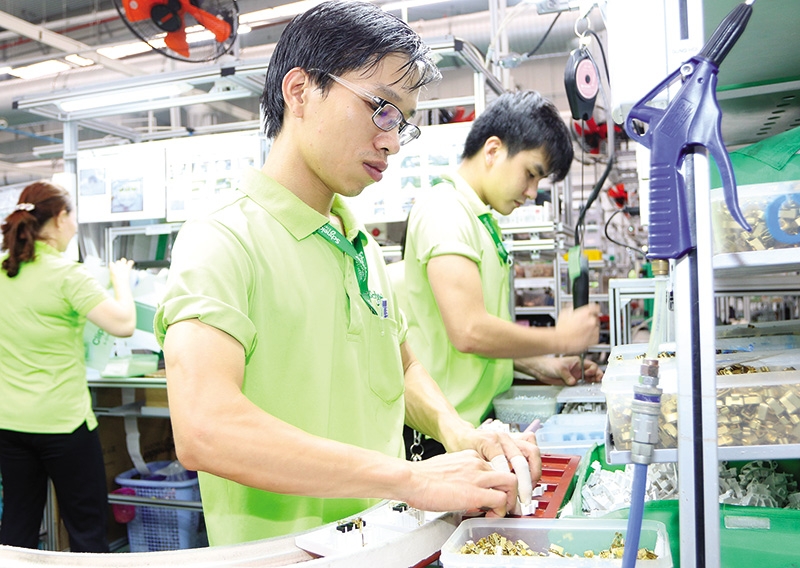Safer investing via fresh EVIPA
 |
| Both deals will improve EU investors’ appetite for investments in Vietnam, Photo: Le Toan |
Minister of Planning and Investment Nguyen Chi Dung signed the EU-Vietnam Investment Protection Agreement (EVIPA) with the EU on June 30, which is expected to contribute positively to the construction of a transparent legal and investment environment for both sides.
The EVIPA includes commitments to equal treatment and safe and adequate protection for each other’s investments and investors, modern rules on investment protection enforceable through the new Investment Court System, and ensures that the rights of the governments on both sides to regulate in the interest of their citizens are preserved. It will replace the bilateral investment agreements that 21 EU member states currently have with Vietnam, putting in place new legal guarantees preventing conflicts of interest and increasing transparency.
The two sides also commit to free flows of capital and profit in investment activities to overseas nations and to refrain from expropriating the assets of investors without compensation. They also pledge to compensate each other’s investors for possible damages from wars and riots as they do with domestic ones, or those of a third nation.
Usually, when there is a dispute between an investor and a host country, investors can reach out to the World Bank’s International Centre for Settlement of Investment Disputes or other similar tribunals permitted under their respective FTA for resolution.
In case of the signed EU-Vietnam Free Trade Agreement (EVFTA), both parties have agreed to set up a permanent court, referred to as the “Tribunal” to handle such issues. This will not only protect investors and their investments but also protect a country’s right to oversee the implementation of public policies. In addition, the court system will be an independent dispute resolution system.
“The signing of FTAs, including the EVFTA, puts pressures on the requirement of sustainable development and deep global integration. To deal with the existing concerns, the Vietnamese government is determined to make reforms and comprehensively restructure the economy,” Minister Dung noted.
As “new generation” FTAs, the EVFTA and EVIPA will help EU investors to access the public procurement and service markets in Vietnam, while strengthening protection of EU investments in the country, thus helping Vietnam attract more investors from the EU and other foreign countries in the coming time. Experts have predicted that the FTAs will boost trade and investment, contributing 7-8 per cent to Vietnam’s GDP by 2025.
Vietnam is the EU’s second-largest trade partner in the ASEAN after Singapore, with trade in goods worth almost €49.3 billion ($56.15 billion) a year and over €3 billion ($3.42 billion) when it comes to services. While EU investment stocks in Vietnam remain modest, standing at €8.3 billion ($9.44 billion) in 2016, an increasing number of European companies are establishing presence in the country to set up a hub to serve the Mekong region.
The EVIPA and the EVFTA are said to be the most ambitious deals concluded between the EU and a middle income country. After being signed, the two deals will be submitted to the European Parliament (EP) for consent. The EVFTA is expected to be approved by the EP later this year or in early 2020. Meanwhile, it will take at least two years for the EVIPA to be ratified by the EP and member parliaments.
Investment protection and arbitration are among the biggest concerns of EU investors in Vietnam. The settlement of commercial disputes has so far not satisfied those involved, and EU businesses in Vietnam are understandably supporting the immediate signing of the EVIPA.
“The EVFTA and EVIPA will create an ecosystem to provide the best available treatment when investing in Vietnam. We will live a long and happy life. Vietnam is our home, and Asia Piaggio continues to develop our operations in Vietnam,” stated Italian group Piaggio, which has two manufacturing plants in the country (one for engines and another for vehicles), as well as a research and development centre that is the first one in Asia among the group’s six centres worldwide.
What the stars mean:
★ Poor ★ ★ Promising ★★★ Good ★★★★ Very good ★★★★★ Exceptional
Themes: EVFTA & EVIPA
Related Contents
Latest News
More News
- EVN launches major power infrastructure projects nationwide (December 19, 2025 | 18:17)
- VAL inaugurates second production line to meet domestic animal feed demand (December 19, 2025 | 16:37)
- Sun Group pioneers urban tram system in Phu Quoc (December 19, 2025 | 15:00)
- Top 10 notable events of Vietnam’s industry and trade sector in 2025 (December 19, 2025 | 14:00)
- Seven major projects launched to drive Hanoi’s next growth phase (December 19, 2025 | 14:00)
- Rare, beautiful, sustainable: the mark of iconic real estate (December 19, 2025 | 08:00)
- Mondelez Kinh Do - a chapter of purpose-led leadership in Vietnam (December 18, 2025 | 09:44)
- VNPAY services receive the highest-level PCI DSS international security certificates for six consecutive years (December 17, 2025 | 23:47)
- F&N deepens investment in Vinamilk (December 17, 2025 | 09:00)
- Long-term capital seen as key hurdle to green growth (December 16, 2025 | 08:00)

 Tag:
Tag:






















 Mobile Version
Mobile Version